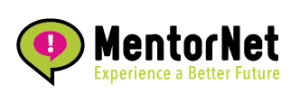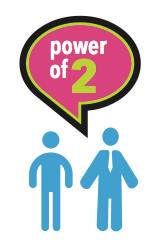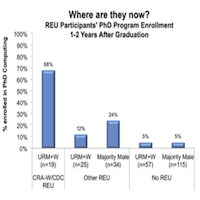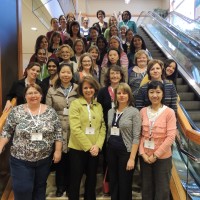A Path Between: Mentoring the Next Generation of Computing Professionals
Note: An extended version of this article appeared in IEEE Computer Society Magazine, Issue on Fostering Gender Diversity in Computing, in March 2013.
 In the US, increasing the number of students who matriculate, graduate, and enter the workforce in science, technology, engineering, and mathematics fields—in particular, computing—is a national imperative. In the next 10 years, more than half of STEM job openings will be in computing, but the US domestic production of computing graduates is estimated to be less than half the anticipated annual demand of 150,000 computing jobs.1
In the US, increasing the number of students who matriculate, graduate, and enter the workforce in science, technology, engineering, and mathematics fields—in particular, computing—is a national imperative. In the next 10 years, more than half of STEM job openings will be in computing, but the US domestic production of computing graduates is estimated to be less than half the anticipated annual demand of 150,000 computing jobs.1
The shortfall of computing professionals is already increasing recruitment and employment costs for employers. More importantly, it will have deleterious effects on the US economy and national security, both of which depend on a well-educated computing workforce.
Luckily, solutions to these problems are at hand—in fact, in our own hands. My 15 years of experience with MentorNet (www.mentornet.org), an online program that matches undergraduate and graduate students in STEM disciplines with working professionals and guides them through a one-on-one mentoring relationship for eight months, demonstrates that individuals can help to diversify and develop the next generation of computer scientists.
You too can become a mentor and grow professionally and personally—not to mention have fun—while doing good.
IRENE’S STORY
In January 2008, I began communicating with Irene, a PhD student I met through MentorNet. For five months, we corresponded regularly about many of the challenges of being a graduate student that I had explored with other protégés: how to get the attention of time-strapped advisors; cope when experiments failed, papers were rejected, and the dissertation was languishing; and prepare for the long-awaited job search, often with spouses and sometimes small children in tow.
In June, Irene asked my advice about how to manage being a mom while in grad school—my first daughter had been born during my final year of grad school, so I had some first-hand experience. Irene explained that she needed to get organized ASAP because her daughter would arrive in August. I was surprised that I didn’t know Irene was pregnant—how could I have missed such a significant detail?
I excitedly congratulated her on her new baby and quickly received a clarification: Irene had a four-year-old daughter currently living in Ghana with her extended family. Two years earlier, Irene and her husband had sent their daughter back to Ghana so they could both focus on their graduate educations here. Without their family nearby to help with child rearing, they were concerned that their educations would be jeopardized, so they made the heart-wrenching decision to separate temporarily.
Irene shared her situation without an ounce of self-pity. While I was awed and humbled by the sacrifice she was making to get a higher education, Irene was unfazed, and simply wanted to know how to get her daughter to nap so she could study!
CHALLENGES TO STEM STUDENTS
 Although Irene’s personal story was unique, my experience as her mentor was familiar in several respects.
Although Irene’s personal story was unique, my experience as her mentor was familiar in several respects.
First, in mentoring relationships, the most important and difficult issues often are revealed after several months, when the protégé and mentor have established trust and can safely move beyond immediate concerns to deeper matters.
Second, like Irene, many of my protégés have made major sacrifices to pursue their higher education, with the common goal and responsibility of improving their own and their family’s economic futures. Many have left loved ones—including spouses and children—thousands of miles away, and might not see them for years at a time.
Last, many STEM students face cross-cultural, gender, and socioeconomic boundaries and stereotypes in pursuit of their higher education. These students require the most support to succeed but unfortunately are the least likely to receive it.
Irene’s obstacles are also typical of those that many STEM students—especially women, underrepresented minorities, and first-generation college students—experience on their path from entering university to becoming a working professional. For these groups, the biggest obstacle on their journey is often not academic but psychological—namely, low self-efficacy or confidence in their ability to succeed at a task in a particular circumstance.1 In Irene’s case, she was worried that she would not meet all her academic goals while being a mom.
When students have role models who are similar to them—in gender, ethnicity, socioeconomic status, or other life circumstances—they have concrete evidence of success, and their self-efficacy increases. But when no such role models exist, they are more likely to perceive obstacles as insurmountable, struggle alone, and ultimately drop out.
BECOMING A MENTOR
As a mentor, I feel that helping students like Irene complete their education is not just an altruistic pastime but critical to the profession’s future.
I began my journey to becoming a mentor as a protégé myself. In 1989, as part of an AT&T Bell Labs fellowship for graduate women, I was provided a mentor, Brian Kernighan. Along the way, I faced many challenges common to young adults in graduate school. My intended advisor left Princeton, which required me to find a new advisor and change subject areas. I got married and had a baby, which plunged me head first into work-life imbalance.
When faced with each new challenge, I had a crisis of confidence and asked myself whether completing the PhD was worth all the stress. Brian reminded me that the degree would open doors that I did not even know existed (he was right!), so it was worth sticking with it. I would not have completed my PhD without Brian’s support, and I knew that the best way to repay his gift was to mentor students myself. In 1998, three years after completing my degree, I joined MentorNet. Today, I am still a MentorNet mentor, and in May 2013, I became MentorNet’s CEO.
MENTORNET
MentorNet is an intervention program for STEM students—literally, a path between the academic and professional worlds.3 Mentors who are STEM professionals show protégé students potential paths by sharing their own life experiences, guide them along their way, and hopefully help launch them into the professional world.
Since 1998, MentorNet has matched more than 32,000 protégés to mentors and measured their progress toward graduation and employment. The data is impressive: More than 90 percent of all protégés have graduated with at least one degree (from AS to PhD) in a STEM field, and 90 percent persist in a STEM field three years after their MentorNet relationship.
The original program served only female students, then added underrepresented minorities before ultimately expanding to serve all STEM students. Today, MentorNet’s original mission is reflected by the significant participation of women and underrepresented minorities in the program: 67 percent of MentorNet protégés are female, 12.7 percent are Hispanic, and 13.8 percent are African American; in comparison, 24 percent of STEM students in the US are female, 6.7 percent are Hispanic, and 6.7 percent are African American.
Matching mentors with protégés
MentorNet makes it possible for protégés and mentors to connect quickly and comfortably and provides them with tools to make their match a success. The program profiles protégés and mentors on about 100 data points regarding their identity, gender, ethnicity, and preferences for a mentor and discussion topics, then matches them one-on-one algorithmically. A protégé typically is presented with several potential mentors and chooses one. This asymmetry is by design: having protégés choose their mentor, not vice versa, provides them with a sense of ownership and also sends a subtle signal that protégés are responsible for their career.
Guiding the relationship with prompts
Once MentorNet matches a protégé with a mentor, it guides their relationship with a curriculum of emailed discussion suggestions or “prompts.” These prompts are sent to both protégé and mentor at timed intervals, about two per month, for eight months.
The program delivers different prompts to different classes of mentor-protégé pairs, taking into account the protégé’s education level (associate degree, bachelor’s degree, master’s degree, doctoral degree, postdoctoral decree, or junior faculty) and the mentor’s professional sector (academic or private). Prompts include 50 different subjects such as setting goals and expectations, persistence and overcoming hurdles, managing your professional online identity, and applying for internships and jobs.
Prompts help both protégé and mentor prepare for the next discussion topic, possibly noting issues that touch on gender or cultural differences, and provide references to additional resources. This on-the-job mentoring model does not require the mentor to be trained in advance—for busy professionals, this lowers the barrier to becoming a mentor.
Maintaining communication
One-on-one mentoring requires a modest time commitment. Surveys of 30,000 mentor-protégé pairs reveal that most people spend on average 15 minutes per week in active communication. This efficiency can be explained by the fact that both parties respond at their convenience and the discussions tend to focus on specific topics. On the other hand, mentors and protégés report that the relationship continually percolates in their minds: both tend to think about the communications they have received and prepare responses between emails or phone calls.
Active communication yields benefits to mentors as well as protégés, including the satisfaction of knowing that they have helped someone else, improved interpersonal and mentoring skills that translate to their professional life, an increased commitment to their field and their employer, and opportunities for self-reflection and -renewal.
LESSONS LEARNED
I believe that I have learned more from my protégés and grown more from our time together than they have. Being a mentor has also done more to prepare me for my current position as a research leader than any other professional activity.
In particular, protégés unknowingly ask questions that require me to reassess my own choices. Early in my mentoring career, one protégé asked me how I managed to have a research career that included a long commute while raising two small children. The answer was, I didn’t. Exhaustion was leading me down a path to potentially chronic illness, with no end in sight. The protégé’s question forced me to face this reality and, not long after, my husband and I decided to move our family close to my office, reducing my daily stress considerably.
Mentoring has taught me to seek transparent and honest communication in my professional relationships. That process can be uncomfortable, but it also is necessary to maintain the functioning of a healthy organization.
Mentoring also has made me aware of how US immigration and education policies impact students in STEM fields and their future employers. Ten of my 17 protégés are natives of Algeria, China, Colombia, Ghana, India, Iran, Malaysia, Poland, and Romania. Given the sacrifices these students make to pursue a higher education and the significant economic value they bring to their adopted country, the high cost and red tape required to secure employment and become permanent residents is discouraging. Seeing this problem up close from both the student and employer perspectives has made me more informed and sensitive when recruiting and hiring.
Attracting students to computing and guiding them on the path from elementary education to a computing career requires the commitment of all computing professionals. The futures of our companies, our economy, and our security are at stake.
Find a mentoring or role-modeling program that suits your interests and schedule. I promise that you will find the experience addictive, and will be reluctant to stop even when you are tired. When I am overwhelmed by obligations at work and home, I consider taking a break from mentoring. But then I receive another email from MentorNet reminding me that “someone is waiting for you.” So I login, accept my match, and once again begin the journey with a hopeful student seeking support and guidance on the “path between.”
References
- ACM, K-12 Computer Science Education: Unlocking the Future of Students, slide presentation, Aug. 2012; www.acm.org/public-policy/2012_CS_Slides_Aug.pptx.
- L.L. Bakken et al., “Effects of an Educational Intervention on Female Biomedical Scientists’ Research Self-Efficacy,” Advances in Health Science Education, vol. 15, no. 2, 2010, pp. 167-183.
- MentorNet, The MentorNet Intervention: A Scalable E-mentoring Program to Support Degree Completion and Provide a Pathway from College to Career, 30 Apr. 2012; http://tinyurl.com/9p2fb52.
Mary Fernández recently became CEO of MentorNet with the objective to provide all STEM students with access to high quality mentoring relationships. Our strategy is to match STEM students and professionals in compatible partnerships that encourage persistence and support academic success and that employ current, evidence-based research on effective mentoring. Together with her partner Coco Brown, Mary is leading the transformation of MentorNet’s technology platform and curriculum to achieve this mission. Mary serves on the board of directors of the Computing Research Association. Contact her at mary@mentornet.net.









